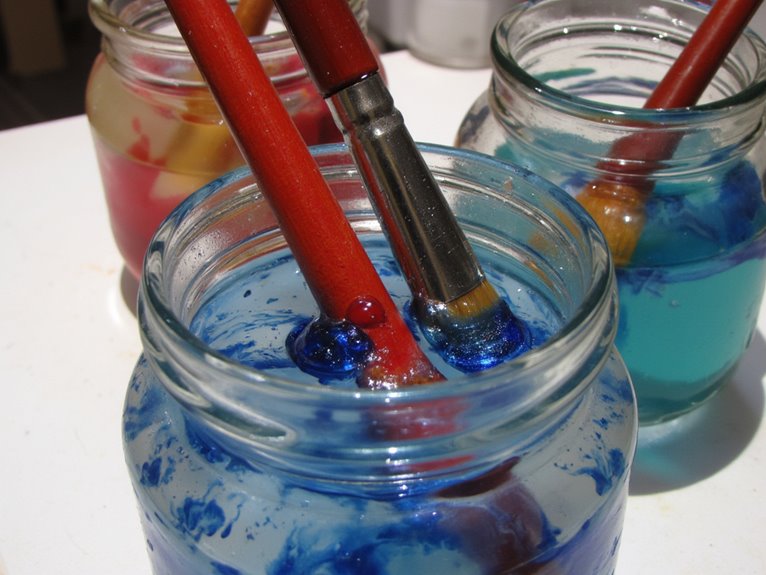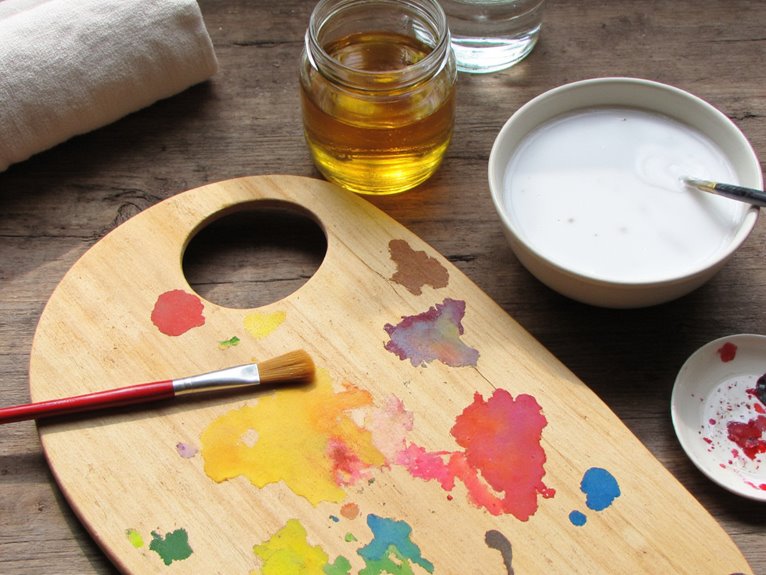We are supported by our audience. When you purchase through links on our site, we may earn an affiliate commission, at no extra cost for you. Learn more. Last update on 1st July 2025 / Images from Amazon Product Advertising API.
Start by wiping excess paint from your brushes using paper towels, working from the ferrule to the tip. Next, swirl brushes in mineral spirits or turpentine for deep paint removal, then rinse with warm soapy water to emulsify remaining oil residues. For eco-friendly alternatives, use Murphy’s Oil Soap or soybean-based cleaners. Condition brushes with linseed oil to maintain bristle flexibility, then store them vertically after complete drying to preserve their shape and performance for future sessions.
Notable Insights
- Remove excess oil paint immediately with paper towels or cloth, wiping from ferrule to tip before cleaning.
- Use mineral spirits, turpentine, or paint thinner to dissolve oil paint, swirling brush gently in solvent.
- Follow solvent cleaning with warm water and dish soap to emulsify remaining oil residues completely.
- Consider eco-friendly alternatives like Murphy’s Oil Soap or soybean-based cleaners to avoid harsh chemical vapors.
- Dry brushes horizontally with bristles sideways, then store vertically upright to maintain proper brush shape.
Removing Excess Paint Before Cleaning
Before you reach for any solvents or cleaning solutions, removing excess paint from your brushes is the most critical step in the cleaning process. Start by wiping off maximum paint using paper towels or kitchen paper. This prevents unnecessary buildup and reduces cleaning time drastically.
Use a cloth to gently pull paint from the bristles, working from ferrule to tip. Tap your brush against container edges after each dip to release excess paint and solvent. Roll the brush through scrap paper to lift remaining residues before applying any liquids.
Excess paint removal techniques save solvents and preserve brush quality. Focus on brush bristle care by removing paint while it’s still wet—this prevents hardening and extends brush lifespan markedly. Always have empty jars ready alongside your cleaning materials for an organized and efficient workspace. Ensure you have proper ventilation by opening a window before beginning the cleaning process.
Using Solvents for Deep Paint Removal

Three primary solvents dominate oil paint removal: turpentine, paint thinner, and mineral spirits.
Mineral spirits offer the best balance of effectiveness and reduced odor for most applications. Select your solvent based on paint compatibility—mineral spirits excel with oil paints and varnishes, while denatured alcohol targets shellac residues specifically.
Choose solvents based on paint type—mineral spirits work best for oil paints while denatured alcohol effectively removes shellac.
Dip your wet brush into the solvent container and swirl gently to dissolve paint from bristles. Tap the brush against container sides to remove loosened paint without dripping. Repeat this process until residues clear, checking progress with clean paper towels.
Solvent safety requires gloves, proper ventilation, and respiratory protection when possible. Never soak brushes for extended periods—this damages bristles. Removing excess paint before using solvents prevents bristle clogging and reduces the amount of solvent needed for effective cleaning. After solvent cleaning, rinse with water to remove any remaining solvent residue from the bristles.
Follow local regulations for solvent disposal since these materials qualify as hazardous waste.
Two-Stage Solvent Cleaning Process
While single-stage solvent cleaning removes most paint, a systematic two-stage approach delivers superior results and extends brush life considerably. The first stage involves thorough solvent immersion and gentle swishing to dissolve surface paint layers.
Limit exposure duration to prevent bristle damage and handle swelling. Tap brushes against container edges to control dripping during transfers.
Stage two introduces soap washing after initial solvent treatment. Warm water mixed with dish soap emulsifies remaining oil residues that solvents loosened but couldn’t eliminate completely. Gentle lathering conditions bristles without harsh scrubbing. The soap emulsifies oil in paint, making it possible to remove with water alone.
Proper brush etiquette requires immediate drying after soap rinsing—never leave brushes soaking indefinitely. Lay brushes flat to prevent residue from seeping back into the ferrule during the drying process.
Maintain solvent safety by using airtight containers with low fill levels. This prevents fume exposure while avoiding ferrule expansion that loosens bristle bonds permanently.
Natural and Eco-Friendly Cleaning Alternatives

Traditional chemical solvents aren’t your only option for effective brush cleaning. Natural alternatives like plant-based oils and specialized eco-friendly cleaners offer safer, non-toxic solutions that protect both your health and the environment.
Products such as Eco-Solve, Murphy’s Oil Soap, and Master’s Brush Cleaner provide powerful cleaning action without harsh fumes or hazardous waste disposal concerns. Walnut oil serves as an excellent alternative cleaner that can be used after thinner for effective brush maintenance.
Eco-Solve and Murphy’s Oil
Natural brush cleaners offer artists safer alternatives to traditional solvents without compromising cleaning effectiveness.
Eco Solve benefits include 100% natural soy bean oil composition that eliminates harmful vapors and skin irritants. This archival-quality cleaner features a subtle fruity licorice scent while preventing yellowing or brush damage over time. You’ll find it doesn’t pollute soil or waterways, supporting eco-friendly practices.
Murphy’s Oil provides gentle oily residue removal without harsh chemicals. It works effectively with warm water to restore and condition brush hairs after initial paint removal.
Both products eliminate VOC exposure and reduce respiratory risks associated with turpentine and mineral spirits.
Clean brushes by swirling in either product after wiping excess paint, then rinse with water. Soap becomes optional since these cleaners effectively remove residual paint while maintaining bristle flexibility.
Master’s Brush Cleaner Benefits
Master’s Brush Cleaner stands out as a versatile cleaning solution that handles multiple paint types while conditioning brush fibers in a single application.
You’ll find it removes oils, acrylics, watercolors, stains, and varnishes without harsh chemical solvents. The formula was developed with cosmetic laboratory expertise, ensuring gentle treatment that maintains bristle flexibility.
This cleaner enhances brush longevity by preventing paint buildup in the ferrule and restoring hardened brushes to near-new condition. Its cleaning efficiency eliminates the need for multiple products or prolonged soaking times.
You can use it on wet or dry paint across various brush types—bristle, sable, and synthetic.
The eco-friendly formulation reduces environmental impact while improving studio air quality, making it a safer alternative to toxic traditional solvents for your regular maintenance routine.
Tackling Dried Paint With Specialized Cleaners
When dried oil paint has transformed your brushes into rigid, seemingly unusable tools, specialized cleaners offer the most effective solution for restoration. These specialized solutions target hardened paint through chemical dissolution rather than mechanical force.
Turpentine, paint thinner, and mineral spirits dissolve oil-based compounds effectively. Soak brushes for 10-15 minutes, then swish gently to penetrate the ferrule area. Multiple applications may be necessary for complete paint removal.
Natural alternatives like Murphy’s Oil Soap provide less toxic brush restoration options. Undiluted soap breaks down dried paint while conditioning bristles simultaneously. Commercial brush cleaners contain formulated solvents specifically designed for hardened oil paint.
Always wear rubber gloves and work in ventilated areas. Follow solvent treatment with warm water and dish soap to remove residues completely.
Conditioning Brushes With Oils and Soaps
After restoring brushes from their hardened state, proper conditioning becomes your next priority to maintain their performance and extend their working life. Oil conditioning involves resting brushes in the same painting medium you used—typically linseed or walnut oil. This prevents bristles from stiffening between sessions while keeping them pliable during active painting.
Position brushes horizontally or bristle-up to maintain their shape and prevent splaying.
Follow oil conditioning with thorough soap cleaning for ideal brush maintenance. Specialized cleaners like Masters Brush Cleaner or simple Ivory soap effectively emulsify oil-based paint residues. Work soap gently through bristles using warm water, repeating cycles until brushes feel completely clean.
Natural alternatives like Murphy’s Oil Soap provide mild, non-toxic cleaning while softening bristles. Always dry brushes promptly after cleaning to preserve ferrule integrity and prevent rusting.
Proper Drying and Storage Techniques
Anyone can ruin quality brushes by rushing the drying and storage process after cleaning. Proper brush drying requires horizontal positioning with bristles facing sideways. This prevents solvents from seeping into the ferrule and weakening the glue that holds bristles in place.
Never dry brushes vertically with bristles pointing up, as moisture will run down into the wooden handle, causing swelling or cracking.
Use flat trays or racks to support brushes during drying. Maintain room temperature between 68-77°F with good ventilation but avoid direct heat sources.
Once completely dry, switch to vertical brush storage with bristles upright to preserve their shape. Store brushes in low-humidity environments with adequate air circulation to prevent mold growth and bristle degradation.
On a final note
You’ll extend your brushes’ lifespan considerably by following proper cleaning protocols. Remove excess paint immediately after each session. Use the two-stage solvent method for thorough cleaning, then switch to eco-friendly alternatives when possible. Don’t let paint dry on bristles—it’s nearly impossible to remove completely. Condition your brushes with appropriate oils and soaps, then store them properly. These techniques will maintain brush flexibility and prevent costly replacements.
